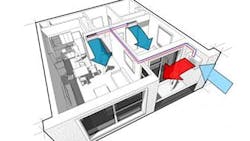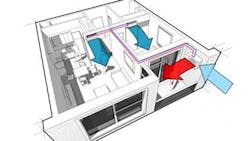In heating, ventilation and air conditioning, the adage "work smarter, not harder" has never been more relevant. The integration of Home Performance into HVAC provides a smarter approach to better serving customers. As the prior owner of a third-generation family HVAC business, my venture to integrate HVAC and Home Performance began in the classroom and transitioned to field application over 30 years ago.
ACCA Manual J load calculations opened my eyes to the accuracy required in HVAC design. This revelation caused us to move beyond inaccurate rule-of-thumb estimations that dominated the industry. It wasn’t until a series of homeowner complaints from a housing development we serviced that we saw the limitations of traditional HVAC approaches. Despite our systems meeting all specifications, the glaring discomfort experienced by residents underscored a missing piece.
Home Performance refers to the overall efficiency and sustainability of a residential structure. It ensures the systems within a home and the home itself are safe, cost effective, and comfortable for the residents.
Thankfully, we discovered Home Performance and the concept of a Blower Door around this time. This was the missing link we sought to answer our homeowner complaints. Armed with this new knowledge, I was determined to integrate this approach into our business. I’m grateful we were successful, but it wasn’t easy. If you’re interested in Home Performance but aren’t sure what it is or how to start, here is an overview and how we used it to solve our first problem job so many years ago.
Defining Home Performance
Home Performance refers to the overall efficiency and sustainability of a residential structure. It ensures the systems within a home and the home itself are safe, cost effective, and comfortable for the residents. This approach involves measuring, evaluating, and optimizing various aspects of a home so they operate at peak performance. These aspects may include:
- Installing HVAC systems, as well as prioritizing filtration and healthy indoor air quality
- Ensuring energy efficiency through proper insulation, sealing air leaks, installing high-quality windows and doors
- Ensuring a durable and safe structural foundation
- Using sustainable materials and resources to limit a home's environmental impact
- Addressing any health and safety issues that may harm the residents.
Owning a home and keeping it operating at optimal health is a significant undertaking. Many homeowners don’t have the educational background, experience, or awareness to maintain their homes on their own. So, they often rely on HVAC professionals. This means you are perfectly positioned to add a Home Performance approach to your work. You just need to expand your perspective and options.
Just like HVAC systems, Home Performance also has standards to meet. These standards help customers know they have chosen the right contractor and give HVAC contractors an understanding of building needs to ensure optimal performance.
When you add Home Performance to HVAC, you prove to customers that you are quality-focused instead of installing what's quickest or easiest. Your recommendations are intentional and driven by metrics. Here is how we used this approach to solve our customers’ problematic home.
Transforming a Baltimore Home
Our customer in Baltimore, MD, lived in a beautiful, 5,775 square feet, brick end-unit townhome. It had a basement and was three stories tall. The family complained of high bills, hot and cold rooms, and no airflow. They reached out to us for budget-friendly HVAC options to improve their overall comfort and energy efficiency of the home. Unfortunately, traditional HVAC couldn't provide the answers they were looking for.
Now that we better understood the building, we recommended a comprehensive assessment. It included High-Performance HVAC system testing, a Blower Door test, and ACCA design protocols. Using these processes, we identified and corrected the root causes of their discomfort and improved their home's comfort and efficiency.
Determining Building Load
We started with a blower door test and Manual J load calculation to determine the heating and cooling loads of the home. We collected all essential building data during a site assessment, and then measured building’s airtightness with a blower door. This test also helped us identify areas of leakage and guided improvements to enhance efficiency and comfort.
By using a Blower Door test, and ACCA design protocols, we identified and corrected the root causes of their discomfort and improved their home's comfort and efficiency.
During the blower door test, we used a powerful fan mounted in an exterior door to depressurize the home. As we tested, we noticed there were ductwork and insulation issues in the basement contributing to excessive infiltration and comfort problems. If we had not taken the time to diagnose these Home Performance issues in addition to looking at the HVAC system, we would have missed a huge opportunity to serve this customer.
Because we took the time to diagnose and treat each issue, we were able to come up with some innovative solutions. We encapsulated the crawl space and redesigned problem pieces of the HVAC system. These solutions provided significant improvements for the customer, were manageable for my team, and allowed them to start off on the right foot.
HVAC Equipment and Ducts
Once we understood the building’s heating and cooling loads, we used the guidelines in ACCA Manual S to select the right HVAC equipment. Contrary to popular belief, the load calculation doesn’t fulfill the equipment sizing guidelines. Once we knew the equipment was right for the home, we moved to the ducts.
Using design principles from ACCA Manual D and test procedures learned from National Comfort Institute, we diagnosed and redesigned the existing duct system. First, we collected data about the existing ductwork system. Measurements like static pressure and airflow provided a baseline about how well the existing system was operating.
Next, we looked for opportunities to improve the overall functioning of the existing duct system. We changed duct elbows from radius to square with vanes allowed for an 80-ft. reduction in supply and return. Adjusting take-offs from standard elbow to top take-offs allowed an additional 30-ft. reduction in supply and return. Similarly, selecting better trunk and branch fittings where accessible also provided a 30-ft. supply and return reduction.
Just by adjusting the duct fittings and installation we were able to decrease pressure losses and improved individual room airflow.
Keeping Customers in Mind
The family in Baltimore asked for lower HVAC costs, consistent temperatures, and regular airflow. Not surprisingly, the family did not ask for a blower door test, crawlspace encapsulation, or better duct fittings and installation.
The opportunity and responsibility of HVAC professionals is to use their knowledge and expertise to provide solutions the customer may not know they need. In this case, by doing thorough assessments from an HVAC and Home Performance stance, we were able to design and deliver long-term solutions that provided the solutions the customers originally asked for. This is a perfect example of HVAC and Home Performance working together.
Moving Forward
As you can see, adding Home Performance to HVAC is not just about upgrading equipment. It's about a holistic perspective that prioritizes the health and comfort of the homes we service. By integrating Home Performance into our HVAC solutions, we can ensure that we're not just solving problems but enhancing lives.
This project reshaped my understanding of what it means to be in the HVAC industry. It's a reminder that our work touches more than just systems and equipment; it profoundly impacts the everyday lives of the people we serve. Home Performance extended our focus beyond just HVAC systems, urging us to consider the home as an interconnected ecosystem. It can do the same things for you.
Rob Minnick is an instructor for National Comfort Institute NCI. He has 44 years’ experience in the HVAC Industry with his family’s business as well as 14 years teaching and training contractors on how to overcome obstacles and be more successful. He can be reached at ncilink.com/Contact Me.
About the Author
Rob Minnick
Certified HVAC Trainer
National Comfort Institute trainer Rob Minnick is a former HVAC contractor with 43 years of experience in the Heating and Air Conditioning field, particularly with Mechanical Design & Building Performance for owners.
He earned his certifications from the State of Maryland, Air Conditioning Contractors of America, Building Performance Institute, Residential Energy Service Network, United States Green Building Council, and National Comfort Institute.
Rob is active in many associations, including ACCA National Products & QA Committee Chair, ACCA/BPI QEE Standard Development Committee, Building Performance Institute (BPI), Building Performance Association, Building Performance Association National Program Committee, ACHR News Advisory Board, HVACRedu.net Program Oversight Committee, Home Energy Magazine's Editorial Advisory Board, and Maryland Youth Apprenticeship Advisory Committee.


